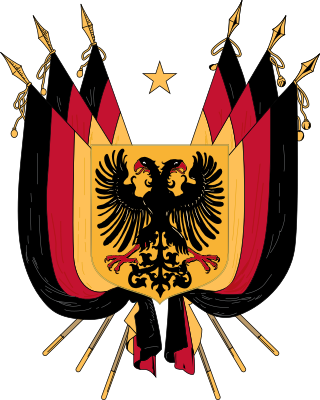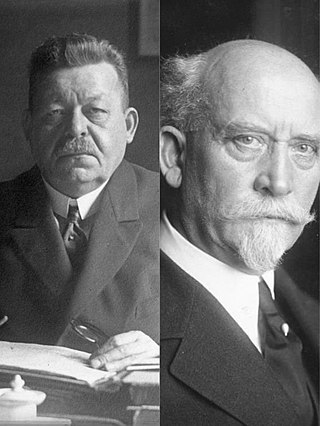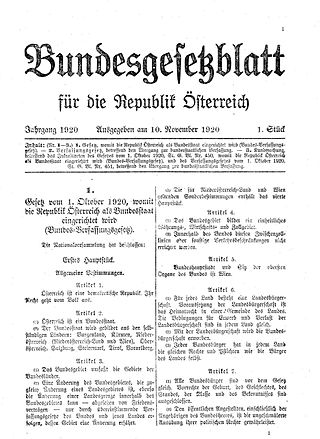The Estonian Provincial Assembly or Estonian State Diet, also often called by its Estonian name Maapäev, was elected in May–June 1917 during the Russian Revolution as the provincial parliament (diet) of the Autonomous Governorate of Estonia. On 28 November 1917, after the October Revolution in Russia, the Assembly declared itself the sole sovereign power in Estonia and called for the elections of the Estonian Constituent Assembly. On the eve of the German occupation of Estonia during World War I the council elected the Estonian Salvation Committee and issued the Estonian Declaration of Independence on 24 February 1918.

The German revolutions of 1848–1849, the opening phase of which was also called the March Revolution, were initially part of the Revolutions of 1848 that broke out in many European countries. They were a series of loosely coordinated protests and rebellions in the states of the German Confederation, including the Austrian Empire. The revolutions, which stressed pan-Germanism, liberalism and parliamentarianism, demonstrated popular discontent with the traditional, largely autocratic political structure of the thirty-nine independent states of the Confederation that inherited the German territory of the former Holy Roman Empire after its dismantlement as a result of the Napoleonic Wars. This process began in the mid-1840s.

The Frankfurt National Assembly was the first freely elected parliament for all German states, including the German-populated areas of the Austrian Empire, elected on 1 May 1848.

The Treaty of Saint-Germain-en-Laye was signed on 10 September 1919 by the victorious Allies of World War I on the one hand and by the Republic of German-Austria on the other. Like the Treaty of Trianon with Hungary and the Treaty of Versailles with the Weimar Republic, it contained the Covenant of the League of Nations and as a result was not ratified by the United States but was followed by the US–Austrian Peace Treaty of 1921.

Karl Josef Seitz was an Austrian politician of the Social Democratic Workers' Party. He served as member of the Imperial Council, President of the National Council and Mayor of Vienna.

The Central Rada of Ukraine, also called the Central Council, was the All-Ukrainian council that united deputies of soldiers, workers, and peasants deputies as well as few members of political, public, cultural and professional organizations of the Ukrainian People's Republic. After the All-Ukrainian National Congress, the Council became the revolutionary parliament in the interbellum lasting until the Ukrainian-Soviet War. Unlike with many other councils in the Russian Republic, Bolshevization of the Rada failed completely, prompting the Ukrainian Bolsheviks to form a rival government in Kharkov.
The Christian Social Party was a major conservative political party in the Cisleithanian crown lands of Austria-Hungary and under the First Austrian Republic, from 1891 to 1934. The party was affiliated with Austrian nationalism that sought to keep Catholic Austria out of the State of Germany founded in 1871, which it viewed as Protestant and Prussian-dominated; it identified Austrians on the basis of their predominantly Catholic religious identity as opposed to the predominantly Protestant religious identity of the Prussians.

Wilhelm Miklas was an Austrian politician who served as President of Austria from 1928 until the Anschluss to Nazi Germany in 1938.

Federal elections were held in Germany on 19 January 1919, although members of the standing army in the east did not vote until 2 February. The elections were the first of the new Weimar Republic, which had been established after World War I and the Revolution of 1918–19, and the first with women's suffrage. The previous constituencies, which heavily overrepresented rural areas, were scrapped, and the elections held using a form of proportional representation. The voting age was also lowered from 25 to 20. Austrian citizens living in Germany were allowed to vote, with German citizens living in Austria being allowed to vote in the February 1919 Constitutional Assembly elections.

The Government of Austria is the executive cabinet of the Republic of Austria. It consists of the chancellor, who is the head of government, the vice chancellor and the ministers.

The Republic of German-Austria and German-Austria was an unrecognised state that was created following World War I as an initial rump state for areas with a predominantly German-speaking and ethnic German population within what had been the Austro-Hungarian Empire, with plans for eventual unification with Germany. The territories covered an area of 118,311 km2 (45,680 sq mi), with 10.4 million inhabitants.

The Council of the People's Deputies was the provisional government of Germany during the first part of the German Revolution, from 10 November 1918 to 13 February 1919. Formed initially by three members each from Germany's two main socialist parties, it shaped the transition from the Empire to the Weimar Republic.

Yugoslavia was a state concept among the South Slavic intelligentsia and later popular masses from the 19th to early 20th centuries that culminated in its realization after the 1918 collapse of Austria-Hungary at the end of World War I and the formation of the Kingdom of Serbs, Croats and Slovenes. However, the kingdom was better known colloquially as Yugoslavia ; in 1929 it was formally renamed the "Kingdom of Yugoslavia".

The Weimar National Assembly, officially the German National Constitutional Assembly, was the popularly elected constitutional convention and de facto parliament of Germany from 6 February 1919 to 21 May 1920. As part of its duties as the interim government, it debated and reluctantly approved the Treaty of Versailles that codified the peace terms between Germany and the victorious Allies of World War I. The Assembly drew up and approved the Weimar Constitution that was in force from 1919 to 1933. With its work completed, the National Assembly was dissolved on 21 May 1920. Following the election of 6 June 1920, the new Reichstag met for the first time on 24 June 1920, taking the place of the Assembly.

The Provisorische Zentralgewalt was the provisional government of the Frankfurt Parliament (1848–49). Since this all-German national assembly had not been initiated by the German Confederation, it was lacking not only major constitutional bodies, such as a head of state and a government, but also legal legitimation. A modification of the Bundesakte, the constitution of the German Confederation, could have brought about such legitimation, but as it would have required the unanimous support of all 38 signatory states this was practically impossible. Partially for this reason, influential European powers such as France and Russia declined to recognize the Parliament. The delegates on the left wanted to solve this situation by creating a revolutionary parliamentary government, but, on 24 June 1848, the majority voted for a compromise, the so-called Provisional Central Power.

The Ukrainian People's Republic (UPR) was a short-lived state in Eastern Europe. Prior to its proclamation, the Central Council of Ukraine was elected in March 1917 as a result of the February Revolution, and in June, it declared Ukrainian autonomy within Russia. Its autonomy was later recognized by the Russian Provisional Government. Following the October Revolution, the Central Council of Ukraine denounced the Bolshevik seizure of power and proclaimed the Ukrainian People's Republic with a territory including the area of approximately eight Russian imperial governorates. It formally declared its independence from Russia on 22 January 1918.

Gustav Groß (1856–1935) was a national liberal German Bohemian politician.

The Federal Constitutional Law is a federal constitutional law in Austria serving as the centerpiece of the Constitution. It establishes Austria as a democratic federal parliamentary republic.

The Constituent National Assembly, elected on 16 February 1919, was the first parliament in Austria's history to be elected by women and men in free and equal elections. On 4 March 1919 it replaced the Provisional National Assembly based on the 1911 Imperial Council elections. The National Assembly adopted the Habsburg Act, ratified the Treaty of Saint-Germain, which sealed the collapse of Cisleithania and demanded Austria's independence from Germany. In its last meeting on 1 October 1920, the assembly created the until-now lasting Constitution of Austria. It was the first time that women in Austria had suffrage in national elections.
A Reichsverweser or imperial regent represented a monarch when there was a vacancy in the throne, such as during a prolonged absence or in the period between the monarch's death and the accession of a successor. The term Verweser comes from the Old High German firwesan and means "for or in the place of a person". The plural form is the same as the singular.



















